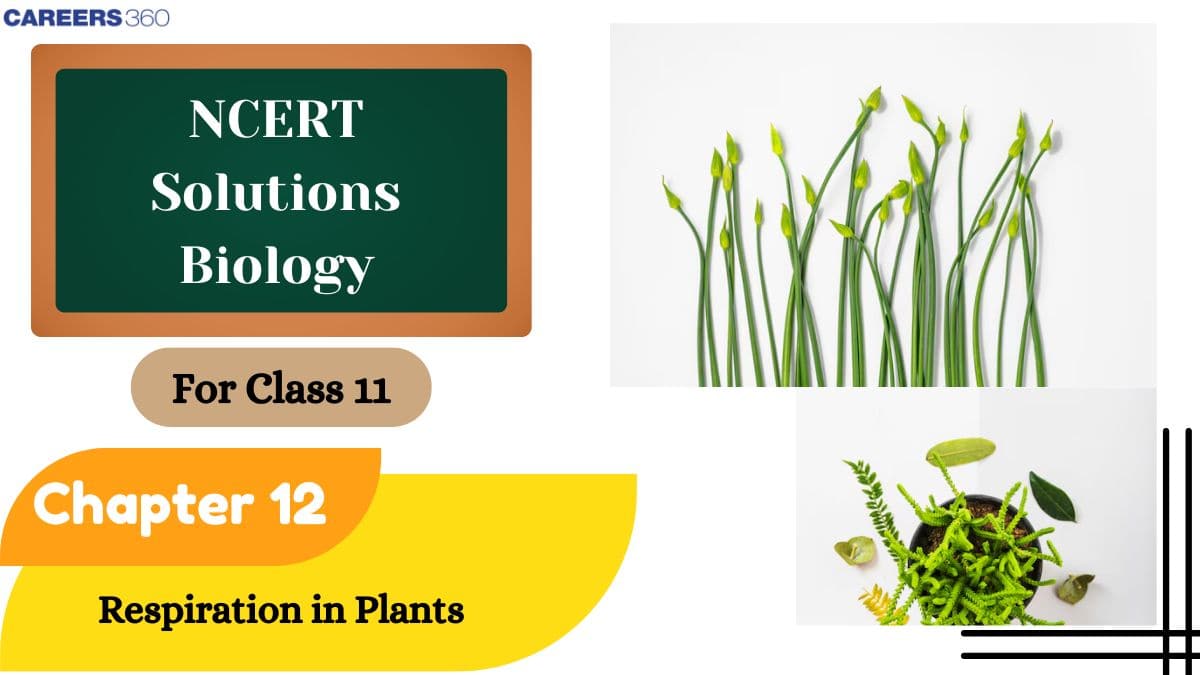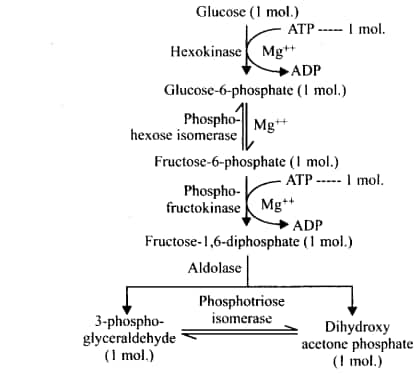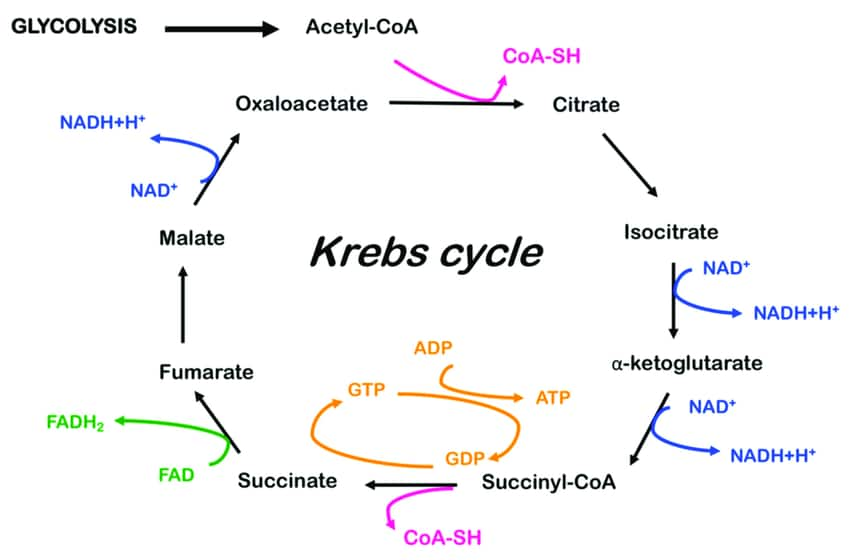NCERT Solutions for Class 11 Biology Chapter 12 Respiration in Plants
The NCERT Solutions for Class 11 Biology Chapter 12 Respiration in Plants explains how plants release energy from food. Plants use different processes like glycolysis, the Krebs cycle, and electron transport. These solutions help students go through the concepts step by step with clear explanations. All textbook questions are answered properly, so students can revise without confusion. The NCERT Solutions are a valuable resource that lays a strong foundation for higher classes.
NEET Scholarship Test Kit (Class 11): Narayana | Physics Wallah | Aakash | ALLEN
Browse: NEET papers with solutions | Most scoring concepts for NEET
This Story also Contains
- Download PDF of Class 11 Biology Chapter 12 NCERT Solutions
- Find the Class 11 Biology Chapter 12 NCERT Solutions (Exercise Questions)
- Approach to Solve Class 11 Biology Chapter 12 Question Answers
- Important Question from Class 11 Biology Chapter 12 NCERT Solutions
- What extra should students study beyond NCERT for NEET?
- Chapter wise NCERT Solutions for Class 11 Biology

Respiration in Plants Class 11 NCERT Solutions will help students understand the complete process of respiration. It also includes how glucose breaks down to form ATP, which is the energy currency of the cell. Following this approach makes it easier to score better in school exams and in competitive exams like NEET. Students can also download the Respiration in Plants Class 11 NCERT Solutions PDF for offline revision.
Also, Read
Download PDF of Class 11 Biology Chapter 12 NCERT Solutions
Chapter 12 explains how plants break down food to release energy, a process known as respiration. It covers important topics like glycolysis, the Krebs cycle, and electron transport. Students can download the PDF for offline study. The NCERT Solutions for Class 11 Biology help with quick revision and better clarity.
Find the Class 11 Biology Chapter 12 NCERT Solutions (Exercise Questions)
The questions with detailed explanations are given below. These are prepared by subject experts to support the learning. Regular practice of Class 11 Biology Chapter 12 question answers helps in effective preparation.
Q1. Differentiate between (a) Respiration and Combustion
Answer:
Feature | Respiration | Combustion |
Where it Happens | Inside living cells | Not in cells, it's a general process |
What Kind of Process | A biological process | A chemical process |
Energy Release | Slowly, step by step | All at once, very quickly |
Energy Form | Mostly as ATP (the cell's energy currency) | No ATP is made |
Needs Help From | Enzymes (special proteins) | Doesn't need enzymes |
Q1. Differentiate between (b) Glycolysis and the Krebs cycle
Answer:
Feature | Glycolysis | Krebs Cycle |
Where it Happens | In the cell's cytoplasm | Inside the mitochondria |
Pathway Shape | A straight pathway | A circular pathway |
Needs Oxygen? | Happens with or without oxygen | Needs oxygen to work |
What it Does | Breaks down glucose into pyruvate | Breaks down pyruvate into CO2 and water |
Uses/Makes ATP | Uses a little ATP to get started | Doesn't use ATP |
Q1. Differentiate between (c) Aerobic respiration and Fermentation
Answer:
Feature | Aerobic Respiration | Fermentation |
Where it Happens | Inside cells | Can happen inside or outside cells |
Economic Use | Not used to making things in the industry | Used to make things like wine and bread |
How it Works | Uses oxygen to break down stuff | Breaks down nutrients without using oxygen |
Q2. What are respiratory substrates? Name the most common respiratory substrate.
Answer: Respiratory substrates are those organic compounds which, during respiration, are being oxidised for the release of energy within living cells. Examples of common respiratory substrates are carbohydrates, proteins, fats, and organic acids. The most frequent respiratory substrate is carbohydrates.
Q3. Give the schematic representation of glycolysis.
Answer: The flowchart of glycolysis is as follows:

Q4. What are the main steps in aerobic respiration? Where does it take place?
Answer: The key steps of aerobic respiration are as follows:
Glycolysis- Cytoplasm
Krebs cycle- Matrix of mitochondria
Electron transport system- Inner mitochondrial membrane
Oxidative phosphorylation- Oxysome in the inner mitochondrial membrane.
Q5. Give the schematic representation of an overall view of Krebs cycle
Answer: Schematic representation of the Krebs cycle

Q7. Distinguish between the following: (a) Aerobic respiration and Anaerobic respiration
Answer: The difference between aerobic respiration and anaerobic respiration is given below:
Feature | Aerobic Respiration | Anaerobic Respiration |
Gas Exchange | It involves the exchange of gases | The exchange of gases is absent |
Oxygen Use | It uses oxygen to break down the respiratory material into simple substances | It does not use oxygen for the breakdown of respiratory substrates. |
Breakdown of Material | The respiratory material is completely broken | The respiratory material is partially broken |
Electron Transport | It involves electron transport | Electron transport is absent |
Q7. Distinguish between the following: (b) Glycolysis and Fermentation
Answer: The difference between Glycolysis and Fermentation is given below:
Feature | Glycolysis | Fermentation |
Oxygen | It is the first step of respiration, which occurs without the requirement of oxygen and is common to both aerobic and anaerobic modes of respiration | It is anaerobic respiration, or respiration which does not require oxygen |
Product | Glycolysis produces pyruvic acid | Fermentation produces different products such as ethanol and lactic acid. |
NADH Production | It produces two molecules of NADH per glucose molecule | It uses NADH produced during glycolysis. |
Q7. Distinguish between the following: (c) Glycolysis and the Citric Acid Cycle
Answer: The difference between Glycolysis and the Citric Acid Cycle is given below:
Feature | Glycolysis | Citric Acid Cycle |
Location | It takes place inside the cytoplasm | It takes place in mitochondria |
Function | It is the first step of respiration in which glucose is broken down to the level of pyruvate. | It is the second step of respiration wherein an active acetyl group is broken down completely |
Q8. What are the assumptions made during the calculation of the net gain of ATP?
Answer: The assumptions used while calculating the net gain of ATP are as follows:
It is supposed that different steps of aerobic respiration, like glycolysis, the TCA cycle, and the ETS, follow one after the other in a regular pathway.
The NADH formed during glycolysis is transported into the mitochondria to undergo oxidative phosphorylation.
The glucose molecule is taken to be the sole substrate, and it is assumed that no other molecule goes into the pathway at intermediate stages.
The intermediates formed in respiration are not used for any other purpose.
Q9. Discuss "The respiratory pathway is an amphibolic pathway."
Answer: The respiratory pathway is amphibolic because it includes both the breakdown (catabolism) and the synthesis (anabolism) of molecules. Carbohydrates, fats, and proteins are broken into their simpler forms, such as glucose, fatty acids, glycerol, and amino acids, before respiration. Molecules of the respiratory pathway, such as acetyl-CoA, are also utilised for the synthesis of fatty acids and proteins.
Q10. Define RQ. What is its value for fats?
Answer: The respiratory quotient (RQ) is defined as the ratio of the volume of CO2 evolved to the volume of O2 consumed during respiration. The value of the respiratory quotient depends on the type of respiratory substrate. The value of RQ for various respiratory substrates is as follows:
Carbohydrates- 1
Fat - 0.7
Organic acids- more than 1
Proteins - less than 1
Q11. What is oxidative phosphorylation?
Answer: Oxidative phosphorylation is the process of generating ATP through the use of energy released from respiration during the oxidation of NADH and FADH2. The process is facilitated by the presence of the enzyme ATP synthase, which is a component of the electron transport system (ETS). In this process, oxidation-reduction reactions build up a proton gradient. There are two components of ATP synthase: F0 and F1. The F0 component is located in the membrane and has a passage for protons, whereas the F1 component is where ADP and inorganic phosphate are converted into ATP. One ATP molecule is produced for every two protons passing through the F0-F1 complex.
Q12. What is the significance of step-wise release of energy in respiration?
Answer: The respiration process occurs stepwise, involving steps such as glycolysis, the TCA cycle, ETS, and oxidative phosphorylation. The synthesis of ATP during respiration is also in every phase. The products obtained in one step of respiration serve as the substrate of the other pathway. Different molecules generated during respiration are also engaged in other biochemical processes. Various respiratory substrates enter and leave the pathway when needed. The ATP also gets used wherever needed, and the rate of reactions of enzymes is also regulated. Hence, step-by-step release of energy increases the efficiency of the system in extracting as well as storing energy.
Approach to Solve Class 11 Biology Chapter 12 Question Answers
Given below are a few steps that students can follow to answer the questions effectively.
Students should begin by understanding the important processes. It includes glycolysis, the Krebs cycle, and the electron transport chain.
They should focus on the difference between aerobic and anaerobic respiration and the role of ATP. Students can use the Respiration in Plants Class 11 NCERT Solutions for clarity.
The flowchart can be used to remember the sequence of reactions and their reagents.
Solving the exemplar questions will give an advanced approach to the chapter. Regular revision of the Respiration in Plants Class 11 NCERT Solutions PDF will improve understanding.
- The NCERT Solutions for Class 11 have all the solved exercise questions. All the answers are to the point and have the necessary information.
NCERT Solutions for Class 11: Subject-wise
Important Question from Class 11 Biology Chapter 12 NCERT Solutions
The solutions are designed to make learning easier for students. Below is an important question from this chapter. For more such questions, students can refer to the Respiration in Plants Class 11 NCERT Solutions.
Q1. What is the end product of oxidative phosphorylation?
Options:
1. NADH
2. Oxygen
3. ADP
4. ATP + H2O
Answer:
This process is mainly used for the oxidation of nutrients by the use of enzymes in order to release energy and molecular oxygen. A metabolic process called oxidative phosphorylation releases chemical energy and oxidises foods to create adenosine triphosphate (ATP) in cells. For the majority of physiological and biochemical functions, including development, mobility, and equilibrium, it serves as the main energy source.
Hence, the correct answer is option (4) ATP + H2O
Check the NCERT Books and NCERT Syllabus here:
What extra should students study beyond NCERT for NEET?
Studying concepts beyond the NCERT will help in improving knowledge for competitive exams like NEET. Some extra concepts that can be studied are given below in the table. Along with these concepts, students should practice the diagrams given in the Respiration in Plants Class 11 NCERT Solutions.
Chapter wise NCERT Solutions for Class 11 Biology
Below are the chapter-wise solutions:
Frequently Asked Questions (FAQs)
The important topics covered in the NCERT Solutions for Class 11 Biology Chapter 12 Respiration in Plants include:
- Do Plants Breathe?
- Glycolysis
- Fermentation
- Aerobic Respiration
- The Respiratory Balance Sheet
- Amphibolic Pathway
- Respiratory Quotient.
Oxidative phosphorylation, given in the NCERT Solutions for Class 11 Biology Chapter 12 Respiration in Plants, is the synthesis of energy-rich ATP molecules. This occurs with the help of energy liberated during the oxidation of reduced coenzymes ( NADH and FADH2 ) produced in respiration. TH enzyme required for the synthesis is called ATP synthase. It is the fifth complex of ETS. During this process, a number of oxidation-reduction reactions occur and lead to the generation of a proton gradient.
Glycolysis is the process by which glucose is converted into pyruvate. It occurs in the cytoplasm of plant cells and is a common pathway for both aerobic and anaerobic respiration. Students can refer to the NCERT Solutions for Class 11 Biology Chapter 12 Respiration in Plants for detailed explanation.
Mitochondria are the powerhouses of the cell because they generate most of the ATP during aerobic respiration through the Krebs cycle and electron transport chain.
Aerobic respiration in plants occurs in the presence of oxygen, fully oxidizing glucose into CO₂ and H₂O, primarily in mitochondria, with a high energy output. Anaerobic respiration occurs without oxygen, partially breaking down glucose into ethanol and CO₂, mainly in the cytoplasm, with a lower energy output.
Popular Questions
Courses After 12th
Study Resources, Applications and Opportunities

Take Aakash iACST and get instant scholarship on coaching programs.

NEET Most scoring concepts
Get nowThis ebook serves as a valuable study guide for NEET 2025 exam.

NEET Previous 10 Year Questions
Get nowThis e-book offers NEET PYQ and serves as an indispensable NEET study material.

JEE Main Important Physics formulas
Get nowAs per latest syllabus. Physics formulas, equations, & laws of class 11 & 12th chapters
JEE Main Important Chemistry formulas
Get nowAs per latest syllabus. Chemistry formulas, equations, & laws of class 11 & 12th chapters
JEE Main high scoring chapters and topics
Get nowAs per latest 2024 syllabus. Study 40% syllabus and score upto 100% marks in JEE

